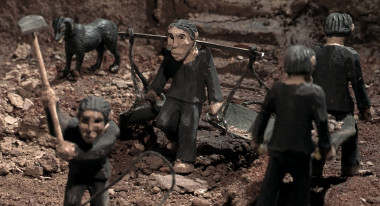These Are a Few of My Favorite Things: New York Film Festival I
The Missing Picture, Rithy Panh, Cambodia
After making several documentaries about the suffering in Cambodia, renamed Campuchea under the Khmer Rouge (1975-79), Panh (The Rice People, S-21: The Khmer Rouge Killing Machine)
has chosen a novel approach to engaging, and educating, the viewer.
Once again he uses archival footage, including rare surviving scenes
from a propaganda film made during that era, but he interweaves it with
contemporary shots of the country today and, most inventively,
hand-painted clay dolls by Sarith Mang, which stand in for victims and
perpetrators. These distancing devices provoke the spectator, and work
in tandem with his voiced-over tales (actually spoken by Randal Douc)
about his family before they were sent to a rural reeducation camp and
during their fatal stay there. The nostalgia brought on by intimate
photos of their bourgeois life in Phnom Penh before deportation is
infectious.
Panh illustrates the huge disconnect between the ideal collective
proletarian paradise (based on Mao and Rousseau) that the Khmer Rouge
envisioned and the reality of life inside the camps, where most people,
given but a meager amount of rice daily, died of hunger and disease. “A
spade is your pen,” their propaganda machine declared, and it does
appear that most of the work entailed digging dirt and hauling rocks.
The Khmer Rouge leaders rejected western medicine and automobiles as
colonialist. They (especially leader Pol Pot) considered themselves
pure, but behind the false front lay brutal tactics.
Hunger is the most frequent topic in the camps, death ever present.
The clay figures have expressive faces, and the sick and dying really do
appear ill and fading. The voice-over speaks about the brainwashed
children who constitute the front lines, telling one horrifying story
about a nine-year-old boy who denounces his mother, which leads to a
death sentence.
The contrasting footage of Phnom Penh before and during the rule of
the Khmer Rouge conveys what words can not describe: A once vibrant
large city became totally deserted. The title points to Panh’s belief
that available images do not reveal the awful truth, that those capable
of doing so are “missing.”
Not to be forgotten is that the ascendancy of the Khmer Rouge followed the extensive bombing of the country by the U.S.


























No comments:
Post a Comment